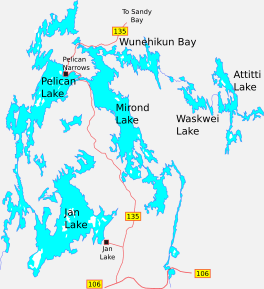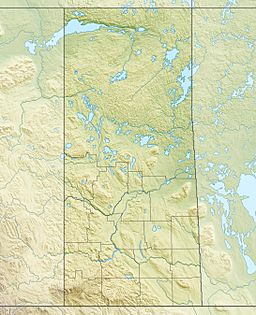Mirond Lake facts for kids
Quick facts for kids Mirond Lake |
|
|---|---|

Mirond (center) and surrounding lakes
|
|
| Coordinates | 55°06′00″N 102°47′01″W / 55.1000712°N 102.7837384°W |
| Type | Lake |
| Basin countries | Canada |
Mirond Lake is a beautiful lake located in Saskatchewan, Canada. It sits in a flat, forested area known as the Canadian Shield. The weather here is quite cold, typical of a subarctic climate.
Contents
Where is Mirond Lake Located?
Mirond Lake is found in Saskatchewan, Canada. You can reach it by driving north from the Hanson Lake Road (Saskatchewan Highway 106).
Size and Connections of Mirond Lake
The lake is about 24 miles (39 km) long. At its widest point, it measures about 5 miles (8 km) across. Mirond Lake is connected to Pelican Lake to its west. This connection is a narrow stretch of water. The community of Pelican Narrows is located on the north shore of this narrow passage.
Attitti Lake, which is to the east, flows into Mirond Lake. Its water travels through Waskwei Lake and Wunehikun Bay first. Mirond and Pelican lakes are close to a high point called the Flin Flon Plain. This plain gently slopes down towards Deschambault Lake and Amisk Lake.
Mirond Lake and the Sturgeon-Weir River System
Mirond Lake is where the Sturgeon-Weir River begins. This river is a branch of the Cumberland Lake system. The water from Cumberland Lake eventually flows into the larger Saskatchewan River System.
The Sturgeon-Weir River leaves Mirond Lake through a rocky channel. This channel has a section of rapids. After the rapids, the river flows more slowly through several long, narrow lakes. This river drains a large area of lakes. These include Deschambault Lake, Wood Lake, Pelican Lake, and Mirond Lake. The Sturgeon-Weir River then empties into Beaver Lake. This is about 90 miles (140 km) northwest of The Pas, Manitoba. The river itself is about 50 miles (80 km) long from Mirond Lake to Beaver Lake.
What Does "Mirond" Mean?
The name "Mirond" comes from the French language. It means "half round" or "half moon." This name describes the shape of the lake. Sir John Richardson, a naturalist, also noted this meaning.
How the Lake Got Its Name
An early mapmaker named Peter Pond spelled the lake's name as "Mineront" around 1785. Other spellings, like Merion, were used later. Sir John Franklin, a famous explorer, wrote "Miron" as "Heron" during his 1819-22 expedition. Other mapmakers copied this mistake. Today, the name Mirond is the official and standard name.
The Cree Name for the Lakes
The Cree people have their own name for Pelican and Mirond lakes. They call them Opawikoschikun Sakuhikuna. This means "fear lakes." This name refers to a significant historical event that took place in the area around 1730. The Cree name for the narrow passage connecting the lakes is Opawikoscikcan, meaning "fear narrows."
Climate Around Mirond Lake
Mirond Lake is located in a subarctic climate zone. This means it has long, cold winters and short, cool summers.
Temperatures in the Region
The average temperature throughout the year is about -1°C (30°F). July is the warmest month, with an average temperature of 16°C (61°F). January is the coldest month, with an average temperature of -24°C (-11°F).
Environment and Wildlife at Mirond Lake
The land around Mirond Lake has different types of soil. There are areas with silts and clays left by ancient lakes. There are also sandy areas from glaciers. Many old, hard rocks from the Precambrian era stick out of the ground. These rocks were smoothed by glaciers long ago.
Plants and Trees
You can find large areas of peatland where the ground is wet. Other parts of the land are covered in forests. Black spruce (Picea mariana) trees are common, but not the only type. Other trees include white spruce (Picea glauca), trembling aspen (Populus tremuloides), jack pine (Pinus banksiana), and balsam fir (Abies balsamea).
Recreation and Fishing
Mirond Lake is a popular spot for outdoor activities. There are lodges with cabins and campgrounds for people who enjoy fishing and hunting. The lake is known for its excellent fishing. In 2008, a record for a live-release northern pike was set here. The fish was an impressive 141 cm (56 inches) long!


